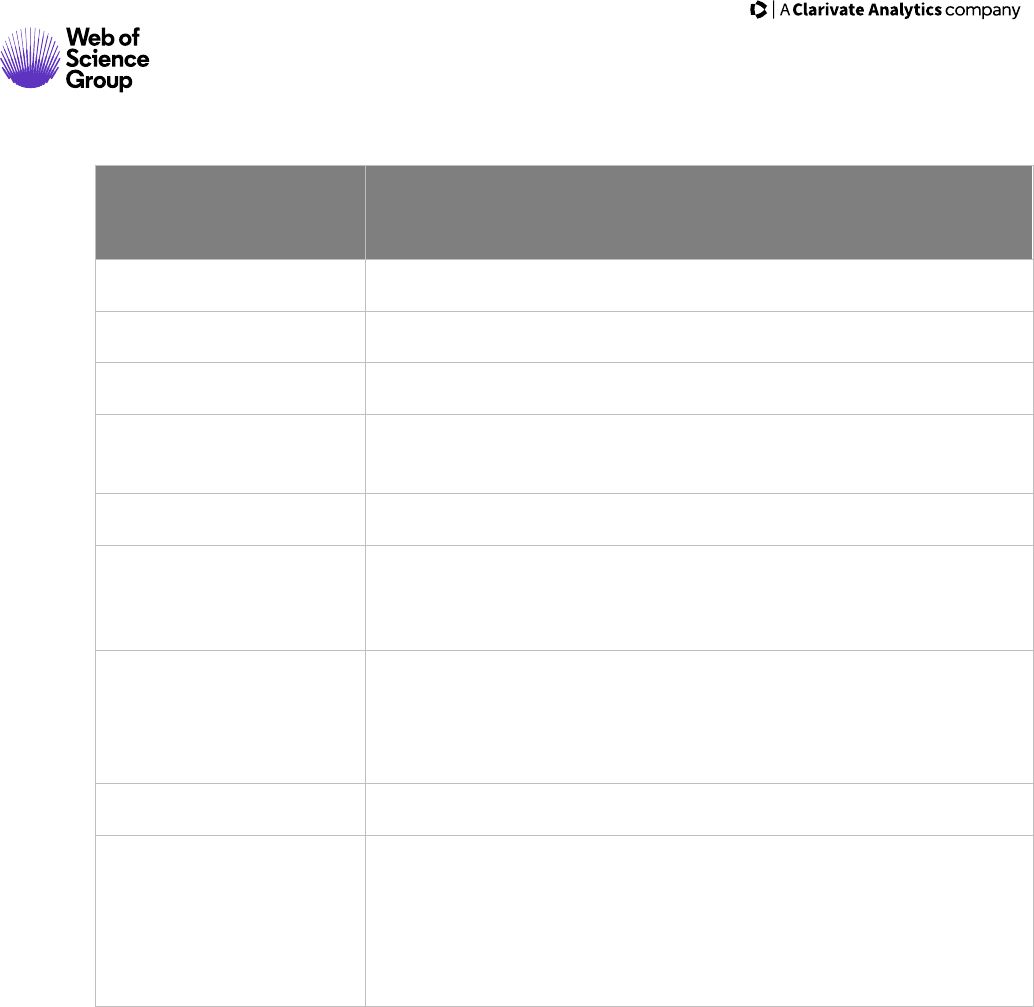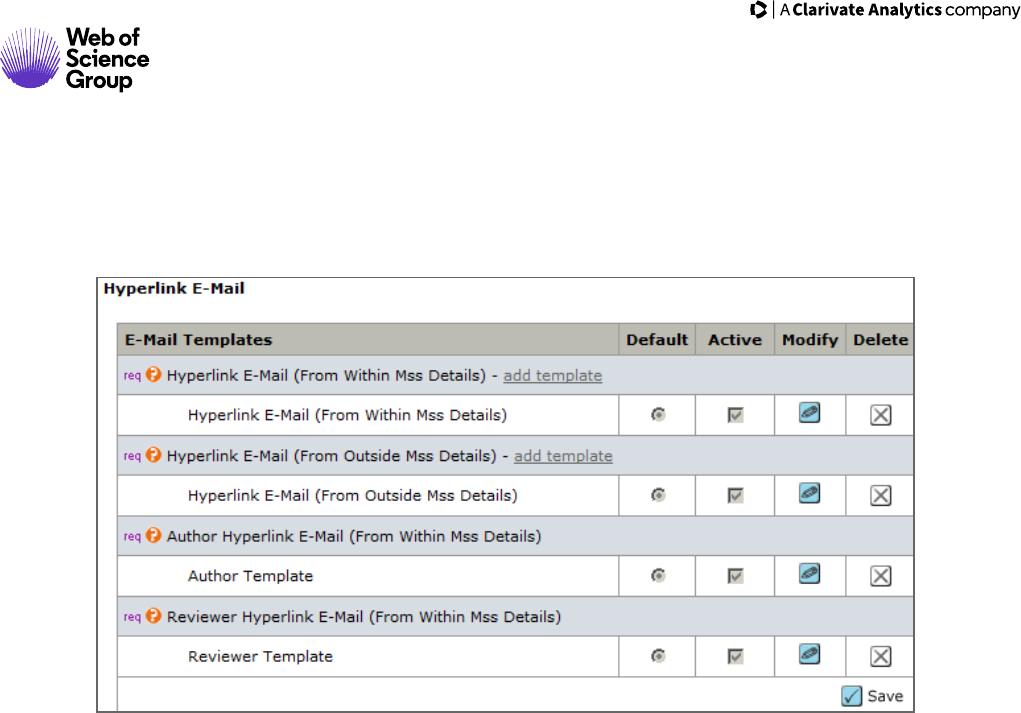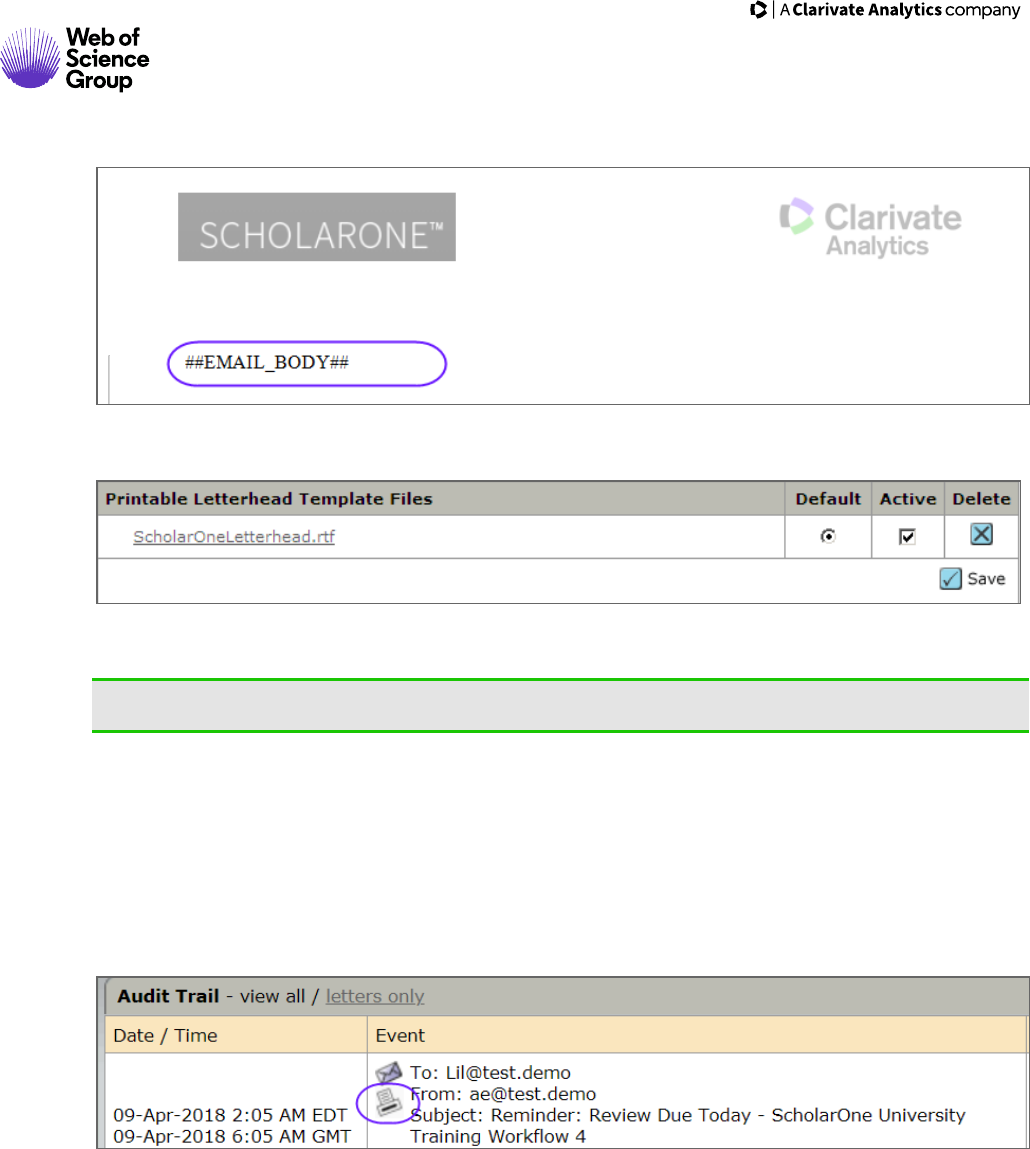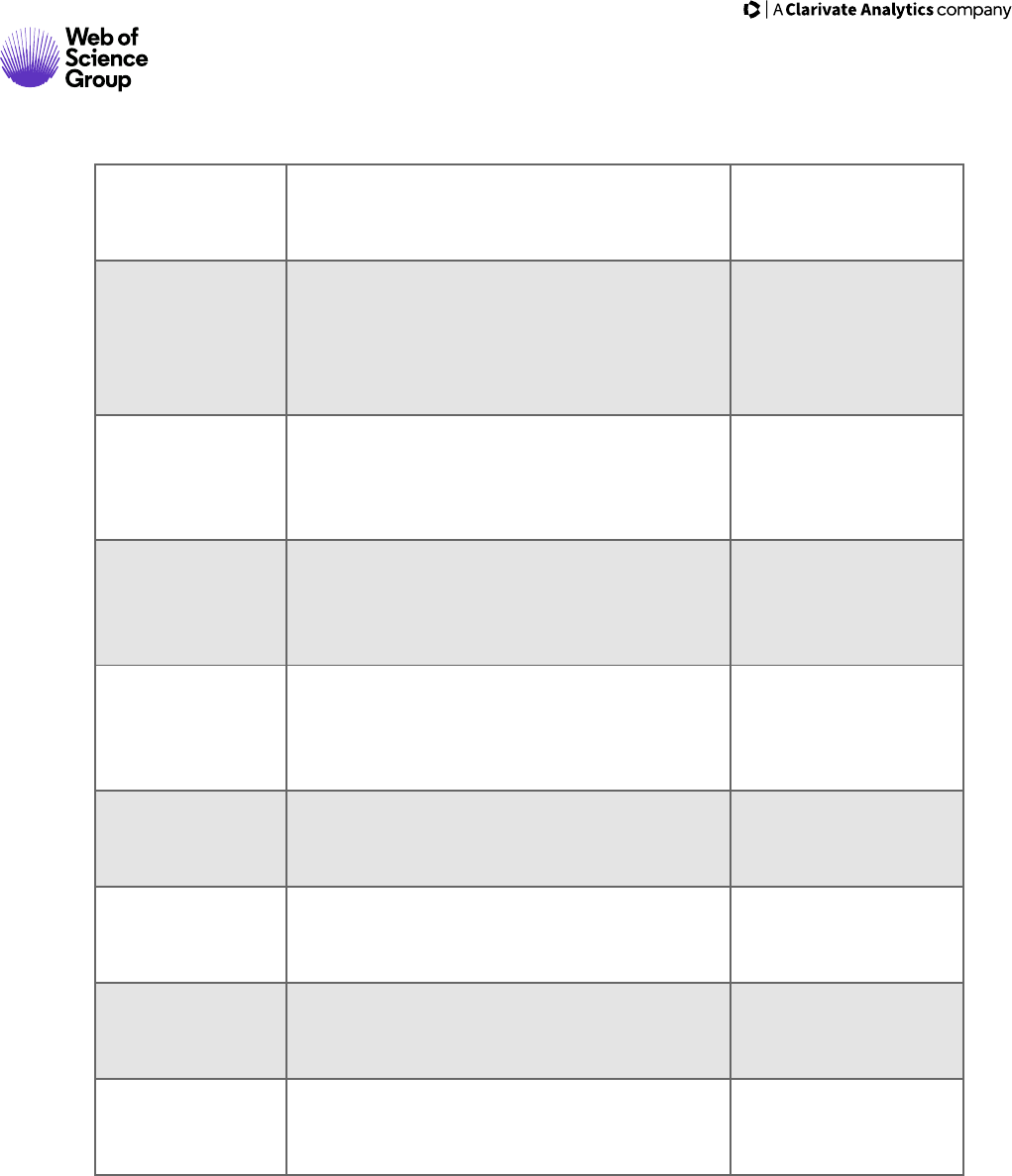
Email Templates
Guide
ScholarOne Manuscripts™

ScholarOne Manuscripts™ | Email Templates Guide Page i
© 2019 Clarivate Analytics
Effective Date: 13-August-2019
Document Version: 1.4
TABLE OF CONTENTS
INTRODUCTION .................................................................................................................................................................... 2
TYPES OF E-MAIL TEMPLATES .............................................................................................................................................. 3
E-mail Notifications and Reminders ............................................................................................................................. 3
WHEN TASK ENTERS? ............................................................................................................................................ 5
REMINDER DAYS .................................................................................................................................................... 7
Invitation E-mails .......................................................................................................................................................... 8
Invitation Response E-mails .......................................................................................................................................... 9
Decision Letters .......................................................................................................................................................... 11
Author Reminders ....................................................................................................................................................... 13
System E-mails ............................................................................................................................................................ 13
E-MAILS FOR AUTHOR / CO-AUTHORS ................................................................................................................ 14
E-MAILS FOR INVITED AUTHOR / MRW ............................................................................................................... 14
ACCOUNT RELATED E-MAILS ............................................................................................................................... 15
MISC EVENT-DRIVEN E-MAILS ............................................................................................................................. 16
Hyperlink E-mails ........................................................................................................................................................ 16
Printable E-mail Letterhead ........................................................................................................................................ 18
HOW PRINTABLE E-MAIL LETTERHEAD WORKS ................................................................................................... 19
EDITING .............................................................................................................................................................................. 21
E-MAIL TAGS ...................................................................................................................................................................... 24
Adding user Defined Tags ........................................................................................................................................... 28
Using PRole and Person Tags ...................................................................................................................................... 28
E-MAIL TOOLS .................................................................................................................................................................... 30
Search and Replace ..................................................................................................................................................... 30
XMl .............................................................................................................................................................................. 31

ScholarOne Manuscripts™ | Email Templates Guide Page 2
© 2019 Clarivate Analytics
Effective Date: 13-August-2019
Document Version: 1.4
INTRODUCTION
All sites are created with a basic set of e-mail templates. When a site is assigned to a journal,
the administrator of the site usually modifies the e-mail templates to the needs of the journal.
This guide is intended to give you an overview of the basic navigation of the e-mail templates
as well as suggestions for editing your templates.
To access the e-mail templates of your site, you must have Administration rights. The e-mail
templates are located in the Admin Tools section under Setup.

ScholarOne Manuscripts™ | Email Templates Guide Page 3
© 2019 Clarivate Analytics
Effective Date: 13-August-2019
Document Version: 1.4
TYPES OF E-MAIL TEMPLATES
When looking at the list of e-mail templates it can be very confusing as to where to start. We
have devised an order of study to assist you with your templates. The order in which to go
through e-mail templates is:
1. E-Mail Notifications and Reminders
2. Invitation E-Mails
3. Invitation Response E-Mails
4. Decision Letters
5. Author Reminders
6. System E-Mails
7. Hyperlink E-mail
8. Printable E-Mail Letterhead
• Items 1-5 follow the basic peer review process of a site.
• Items 6 and 7 are additional types of e-mail templates.
• Item 8 is an additional feature that can be used in conjunction with your e-mail
templates.
E-MAIL NOTIFICATIONS AND REMINDERS
These templates are linked to tasks within the peer review process. They facilitate
communications between Admin, Editors, and Reviewers; to notify someone if they have a task
that is pending or overdue. Typically these notifications are automated but can be customized
and adjusted as needed.
Each workflow in the site has its own set of e-mail templates.
• Submitted Workflow Tasks (SW)

ScholarOne Manuscripts™ | Email Templates Guide Page 4
© 2019 Clarivate Analytics
Effective Date: 13-August-2019
Document Version: 1.4
• Resubmitted Workflow Tasks (RSW)
• Revised Workflow Tasks (RW)
• Appealed Workflow Tasks
• Accept Workflow Tasks
• Invited Workflow Tasks (IW)
Note: Some sites do not contain the Resubmitted or Appealed Workflow.
Each section of E-mail Notifications and Reminders templates contains the following layout:

ScholarOne Manuscripts™ | Email Templates Guide Page 5
© 2019 Clarivate Analytics
Effective Date: 13-August-2019
Document Version: 1.4
SCREEN
COMPONENT
DESCRIPTION
Workflow The name of the workflow.
Task The name of the task within the workflow.
Template The e-mail templates associated with the task.
Edit Before Sending If checked, the e-mail may be edited before being sent. Allows
customization if needed.
Active If checked, the template is used. Unchecked templates are not used.
When Task Enters? This is a trigger to when an e-mail is sent. Select from a list of statuses.
When the manuscript enters the selected status, it is sent. Use either
this field or Reminder Days. (See below for details.)
Reminder Days This is a trigger to when an e-mail is sent. Enter the number of days
before or after the manuscript enters that status for the e-mail to be
sent. Use either this field or When Task Enters? (See below for
details.)
Modify Click the Modify button to edit the template.
Delete Click the Delete button to delete the template. It is not recommended
to delete templates. Instead, simply uncheck the Active checkbox if
you do not want to use a specific e-mail template.
If you Delete an e-mail template and decide you need it later, you will
have to create a brand new template.
When Task Enters?
The When Task Enters? section contains a dropdown of the following:
• Pending: Has entered the task, but is not completed (e.g., pending Admin Checklist)
• Processing: Has been started, but is not completed (e.g., 2 reviews agreed, none
submitted)

ScholarOne Manuscripts™ | Email Templates Guide Page 6
© 2019 Clarivate Analytics
Effective Date: 13-August-2019
Document Version: 1.4
• Overdue: A task is in an overdue status when the number of days given to the task
has expired
• Completed: The Task has been completed (e.g., reviewer has submitted review)
• Abandoned: Still open when decision is made (e.g., reviewer has agreed to review
but has not completed the review when the EIC makes decision)
• Rescinded: Moving a manuscript back one step (e.g., rescind review or decision)
• Closing: When the task is still open and a decision has been made before the task is
completed. (e.g., when the option “allow reviewer to submit a scoresheet after a
decision is made”, the status Reviewer Score task is “Closing”)

ScholarOne Manuscripts™ | Email Templates Guide Page 7
© 2019 Clarivate Analytics
Effective Date: 13-August-2019
Document Version: 1.4
Reminder Days
An example of E-mail Notifications and Reminders is the reminders for Reviewers, listed under
the Task of Reviewers Score.
In this section you will often see 2 or more reminders set at a numeric value. Sites are
configured with a number of days that a reviewer has to complete their review.
• 7 means the e-mail will automatically be sent 7 days after the task is due
• -7 means the e-mail will automatically be sent 7 days before the task is due
• 0 means the e-mail will automatically go out on the day it becomes overdue
Note: The When Task Enters? section must be set at “---“ if you are using a number in the
Reminder Days column.
Tip: This is a great section to add additional e-mail templates if Reviewers need more
reminding to complete reviews in a timely fashion.

ScholarOne Manuscripts™ | Email Templates Guide Page 8
© 2019 Clarivate Analytics
Effective Date: 13-August-2019
Document Version: 1.4
INVITATION E-MAILS
These templates are typically the invitation to reviewers.
Required for Event? must be checked in order for the invitation task to take place. This means
that you must send an invitation e-mail in order for the system to move the process forward to
the invited stage. If you do not select Required for Event?, no e-mail would be sent to the
reviewer to alert them to the invitation, however the system would show them reviewer as
having been “Invited”.
Multiple templates can be created if special types of invitations are needed for a site. These
extra invitations could be based upon Manuscript Type, or when a special person is being asked
to review and a more formal letter is needed.
The invitation e-mails will be preloaded with e-mail tags that will pull in document information
as well as a tag that will create automatic response links for the reviewer to quickly respond to
the invitation.
Types of tags you will find preloaded are:
##DOCUMENT_TITLE##
##DOCUMENT_AUTHORS## - (unless the site is double blinded)
##DOCUMENT_ABSTRACT##
##DOCUMENT_ID##
##INVITE_RESPONSES## - This tag will create links for Agreed, Decline, or Unavailable
(see example below of how the links will look in an e-mail.)

ScholarOne Manuscripts™ | Email Templates Guide Page 9
© 2019 Clarivate Analytics
Effective Date: 13-August-2019
Document Version: 1.4
Note: The links are unique to each reviewer who receives an invitation. Do not copy and paste
links from one reviewer invitation to another.
INVITATION RESPONSE E-MAILS
These templates are triggered when a response is received from a reviewer. As with Invitation
e-mails, Required for Event? must be checked in order for the invitation response task to take
place.
Tip: The Admin or Editor e-mail address could be set up in the CC or BCC field if a role needs
to be copied on all responses. This will increase the amount of e-mail to a person’s
inbox if you set up your responses in this fashion.

ScholarOne Manuscripts™ | Email Templates Guide Page 10
© 2019 Clarivate Analytics
Effective Date: 13-August-2019
Document Version: 1.4
Note: Avoid setting up multiple e-mails templates for a single task in the Submitted Workflow
Tasks section. If the site is using automatic response links in the Invitation E-mails, the
system cannot match up which custom Invitation Response E-mail to send.
The Agreed e-mail has been formatted with a tag called ##REVIEW_LINK##. This tag will give
the reviewer the ability to access the paper they agreed to review without having to know their
User ID or password.

ScholarOne Manuscripts™ | Email Templates Guide Page 11
© 2019 Clarivate Analytics
Effective Date: 13-August-2019
Document Version: 1.4
DECISION LETTERS
These templates are the final decisions that are sent to Authors. This is also a section where
multiple templates can be of great assistance. Multiple decision letters can be created under
each decision type, as well as a thank you letter to reviewers.
When creating multiple decision letters, Edit Before Sending, Active and Required for Event?
must be checked
When creating an “extra” e-mail like the Thank You to Reviewers, do not select Required for
Event? For this template, as this would not allow it to go out from the system as an “extra” e-
mail.

ScholarOne Manuscripts™ | Email Templates Guide Page 12
© 2019 Clarivate Analytics
Effective Date: 13-August-2019
Document Version: 1.4
The Thank You to Reviewers e-mail will contain a tag in the BCC field called:
##TASK_ALL_REV_EMAIL_CLOSED##. The tag blind carbon copies all reviewers who completed
a review for the submission.

ScholarOne Manuscripts™ | Email Templates Guide Page 13
© 2019 Clarivate Analytics
Effective Date: 13-August-2019
Document Version: 1.4
AUTHOR REMINDERS
The Author Reminders are typically used to remind the Author when their
revision/resubmission is due. The Reminder Days column determines when the reminder is
sent out. Each revision/resubmission decision has a set number of days as to how long the
Author has to submit. Another option for the Author reminders is to CC or BCC the Admin
and/or the Editor on the reminder.
Tip: Explain in the reminder to the Author that the link to create their revision/resubmission
will be closed if they do not ask for an extension.
SYSTEM E-MAILS
System E-mails are triggered by non-workflow events. These templates are divided into the
following sections:
• E-Mails for Authors / Co-Authors
• E-Mails for Invited Author / MRW
• Account Related E-Mails
• Misc. Event-Driven E-Mails

ScholarOne Manuscripts™ | Email Templates Guide Page 14
© 2019 Clarivate Analytics
Effective Date: 13-August-2019
Document Version: 1.4
E-Mails for Author / Co-Authors
This section of templates will contain the e-mails used for notifying the Author of the receipt of
the original submission, or if their paper has been Unsubmitted or Withdrawn.
Tip: Add text to the Original Manuscript Submission Confirmation letting the Author know
how long it may take to receive a decision on their paper. This can help reduce the
number of inquiries a journal office receives from Authors regarding the status of their
paper.
E-mails for Invited Author / MRW
If you are using the Invited Author feature of the system these templates are used for
reminding an Author that they have been invited to submit but have not yet responded, as well
as the ability to Unassign or Uninvite an Author.

ScholarOne Manuscripts™ | Email Templates Guide Page 15
© 2019 Clarivate Analytics
Effective Date: 13-August-2019
Document Version: 1.4
Account Related E-Mails
A good practice for the Account Related E-Mails is to leave them at the standard and not edit
the templates.

ScholarOne Manuscripts™ | Email Templates Guide Page 16
© 2019 Clarivate Analytics
Effective Date: 13-August-2019
Document Version: 1.4
Misc Event-Driven E-Mails
This section contains e-mail(s) for the Broadcast E-mail feature in the Admin Dashboard. It also
contains special e-mails used to remind Reviewers that they have been invited to a paper and
not yet responded and e-mails for Unassign Editor and Assign a new Editor.
If you are exporting accepted papers to an FTP site, there is also e-mail for notification if the
export fails.
For sites that use Plagiarism Checking, notifications for this feature are also located here.
HYPERLINK E-MAILS

ScholarOne Manuscripts™ | Email Templates Guide Page 17
© 2019 Clarivate Analytics
Effective Date: 13-August-2019
Document Version: 1.4
A Hyperlink E-mail is used anywhere a person’s name is underlined in the system. These
templates contain basic information in the From, To and Subject line and do not need to be
edited.
You may create extra Hyperlink E-mails for shortcuts for communications that take place
outside the normal workflow process. These templates are available from a drop-down list
when e-mailing a person.

ScholarOne Manuscripts™ | Email Templates Guide Page 18
© 2019 Clarivate Analytics
Effective Date: 13-August-2019
Document Version: 1.4
PRINTABLE E-MAIL LETTERHEAD
E-mails are plain text only, meaning that there is no ability to add color or logos. Printable E-
mail letterhead allows sites to have their letterhead in the system and can be used to recreate
a sent e-mail on to the letterhead and then resend as a PDF file.
Create a .RTF file with the journal or society logo, address and e-mail tag called:
##EMAIL_BODY##

ScholarOne Manuscripts™ | Email Templates Guide Page 19
© 2019 Clarivate Analytics
Effective Date: 13-August-2019
Document Version: 1.4
Upload the file and make it Default and Active.
Tip: If needed, you can upload more than one letterhead.
How Printable E-mail Letterhead Works
In the Audit Trail of each submission, you will see a new icon for each e-mail that has been sent
from the system.
Select the printer icon to open the e-mail on screen and select Open.

ScholarOne Manuscripts™ | Email Templates Guide Page 20
© 2019 Clarivate Analytics
Effective Date: 13-August-2019
Document Version: 1.4
The e-mail is now ready to be saved as a PDF file and resent as a file attachment.

ScholarOne Manuscripts™ | Email Templates Guide Page 21
© 2019 Clarivate Analytics
Effective Date: 13-August-2019
Document Version: 1.4
EDITING
When editing e-mail templates, look for the “req” symbol next to templates that should not be
turned off or deleted.
When editing e-mail templates, also look for the orange question mark (?). When you click on
the question mark, a text box will appear that tells you when the e-mail is triggered, where it is
triggered from, and who can trigger the e-mail.
To edit an e-mail template, click the Modify button for the specific template.

ScholarOne Manuscripts™ | Email Templates Guide Page 22
© 2019 Clarivate Analytics
Effective Date: 13-August-2019
Document Version: 1.4
All templates have the ability to have files attached to them, for example, if you need a
copyright form sent to an author when the acceptance letter is sent.
Another template that may also need a file attached, might be the Reviewer Agreed e-mail if
you wanted to send a reviewer journal specific instructions on how reviews should be
conducted.
The PDF proof of a manuscript submission can be selected as a file attachment and added to
email templates. Many reviewers want to see a copy of the PDF proof before they agree to
review a manuscript.
The system will support the ability to attach the PDF proof to the following email templates:
• Decision Letters

ScholarOne Manuscripts™ | Email Templates Guide Page 23
© 2019 Clarivate Analytics
Effective Date: 13-August-2019
Document Version: 1.4
• Invitation Emails
• Invitation Response Emails
• Emails Notifications and Reminders
• Hyperlink Emails (From within Ms Details)
• Various System emails
Tip: Any file you attach to a template should be a PDF and not a Word document.

ScholarOne Manuscripts™ | Email Templates Guide Page 24
© 2019 Clarivate Analytics
Effective Date: 13-August-2019
Document Version: 1.4
E-MAIL TAGS
E-mail tags are used in all templates. These tags act like a placeholder and know exactly what
information to pull into an e-mail when it is sent from the system. To access the tag list, click
on the View E-mail Tags icon located to the right of the Subject line in the Edit E-mail section
of a template.

ScholarOne Manuscripts™ | Email Templates Guide Page 25
© 2019 Clarivate Analytics
Effective Date: 13-August-2019
Document Version: 1.4
The tag list is broken out into different sections:
Type of Field Description of Tag Examples
Person Fields
These tags will usually reflect the
properties of the e-mail recipient (in some
cases, the PROLE tags are used instead)
First Name, Full
Name, Country, User
ID, Password
User Fields
These tags will reflect the properties of the
user who is currently logged in to the
system.
Same
Site Fields
These tags will contain journal-specific
information. Some of these are pulled
from the Configuration Settings fields that
Admins complete.
Journal Name,
Support Phone,
Admin E-mail, Site
URL

ScholarOne Manuscripts™ | Email Templates Guide Page 26
© 2019 Clarivate Analytics
Effective Date: 13-August-2019
Document Version: 1.4
Document Fields
These tags will reflect the properties of the
current manuscript.
Authors, Title, Date
Submitted, Abstract
Document Roles
These tags will reflect the properties of
people associated with the manuscript.
These can be used to represent either the
sender or the recipient of the e-mail.
Author Full name,
Reviewer E-mail,
Associate Editor
Institution
Attributes
These tags will reflect the attributes
(keywords, areas of expertise) configured
for the site.
Attributes, Keywords
Custom
Questions
These tags will reflect the answers to any
custom questions requested by the
journal.
# of Color Figures,
Conflict of Interest
Document Task
Fields
These tags will reflect items concerning
the peer review of the manuscript.
Editor
Recommendation,
Comments to Author
Invitation Fields
Invitation Fields
Invitation Responses
Link
Invited Paper /
MRW Fields
These fields will reflect items concerning
Invited Papers and MRWs.
Topic Description,
Topic Title
Transfer
Document Fields
Transfer Document Fields
Target Journal,
Target Admin Name
User Defined
Fields
User Defined Fields
Editorial Board,
Review Manager
To add a tag into a template, highlight the tag with your mouse and then right-click to copy.

ScholarOne Manuscripts™ | Email Templates Guide Page 27
© 2019 Clarivate Analytics
Effective Date: 13-August-2019
Document Version: 1.4
In the template, put your cursor where you want the tag to appear and right-click to paste.
The tag will then appear where you need it.
Tip: At the bottom of the tag list there is a button to export the tag list into a CSV file.

ScholarOne Manuscripts™ | Email Templates Guide Page 28
© 2019 Clarivate Analytics
Effective Date: 13-August-2019
Document Version: 1.4
ADDING USER DEFINED TAGS
At the bottom of the tag list there is a link to add User Defined Tags. These tags can be for
journal specific items, such as the Editorial Board e-mail addresses, or even a link to the
registration for the annual meeting for a society.
USING PROLE AND PERSON TAGS
PROLE describes the person or group of persons within a role. PERSON tag describes the single
individual who needs to receive the e-mail.
Example: If you put a PROLE tag in the “To” field of a Reviewer Reminder all Reviewers would
be notified about the one PERSON who is late.
Therefore, we use the PERSON tag in the “To” field of a Reviewer Reminder.

ScholarOne Manuscripts™ | Email Templates Guide Page 29
© 2019 Clarivate Analytics
Effective Date: 13-August-2019
Document Version: 1.4

ScholarOne Manuscripts™ | Email Templates Guide Page 30
© 2019 Clarivate Analytics
Effective Date: 13-August-2019
Document Version: 1.4
E-MAIL TOOLS
SEARCH AND REPLACE
This is the ability to search and replace text in the e-mail templates.
Note: This tool works across all templates not just a specific section of templates.

ScholarOne Manuscripts™ | Email Templates Guide Page 31
© 2019 Clarivate Analytics
Effective Date: 13-August-2019
Document Version: 1.4
XML
If you are familiar with XML, you can download all the templates in your site and edit them
offline, and then upload the edited version.
Note: You cannot delete any items in the XML, as it will throw off the order of your templates
when you upload the edited file.
Tip: If you are going to use the XML option, keep a copy of the original XML.

ScholarOne Manuscripts™ | Email Templates Guide Page 32
© 2019 Clarivate Analytics
Effective Date: 13-August-2019
Document Version: 1.4
About Web of Science Group
Web of Science Group, a Clarivate Analytics company, organizes the world’s research information to enable
academia, corporations, publishers and governments to accelerate the pace of research. It is powered by Web of
Science – the world’s largest publisher-neutral citation index and research intelligence platform. Its many well-
known brands also include Converis, EndNote, Kopernio, Publons, ScholarOne and the Institute for Scientific
Information (ISI). The ‘university’ of Web of Science Group, ISI maintains the knowledge corpus upon which the
index and related information and analytical content and services are built; it disseminates that knowledge
externally through events, conferences and publications and it carries out research to sustain, extend and improve
the knowledge base. For more information, please visit webofsciencegroup.com.
© 2019 Clarivate Analytics. All rights reserved. Republication or redistribution of Clarivate Analytics content,
including by framing or similar means, is prohibited without the prior written consent of Clarivate Analytics. Web
of Science Group and its logo, as well as all other trademarks used herein are trademarks of their respective
owners and used under license.
